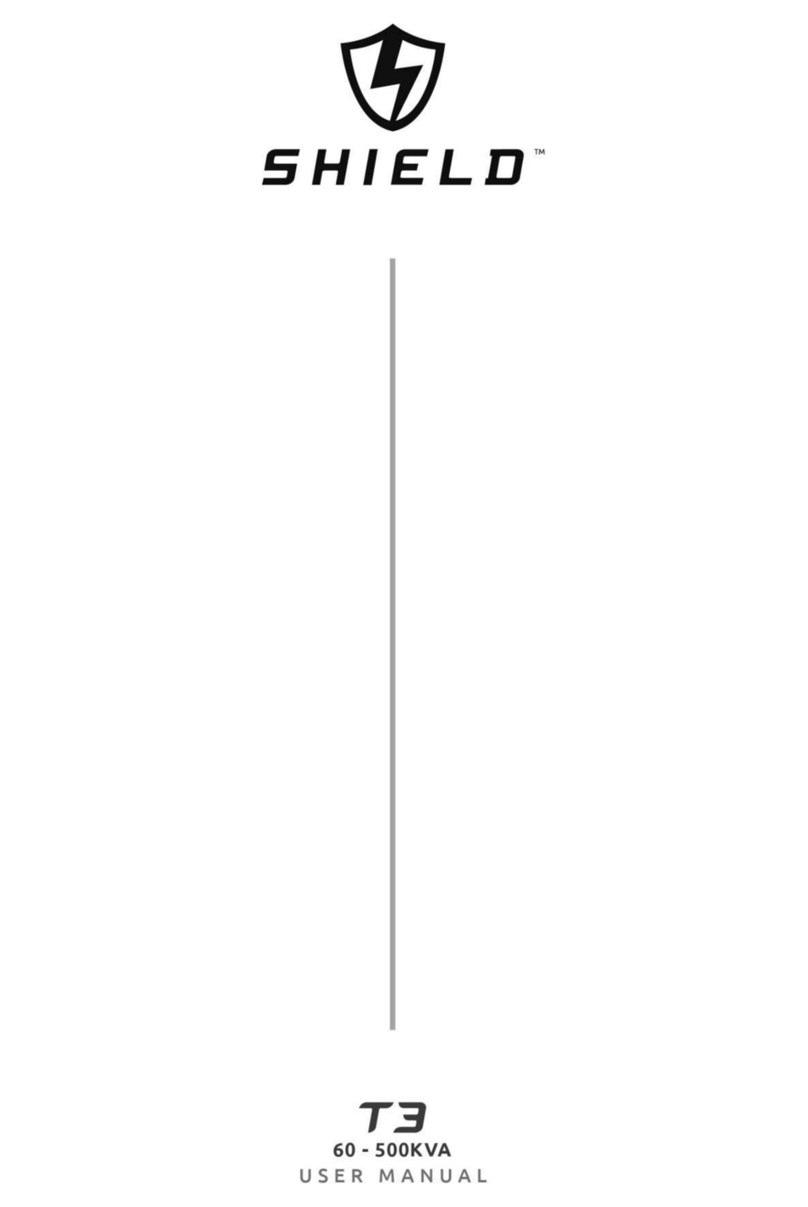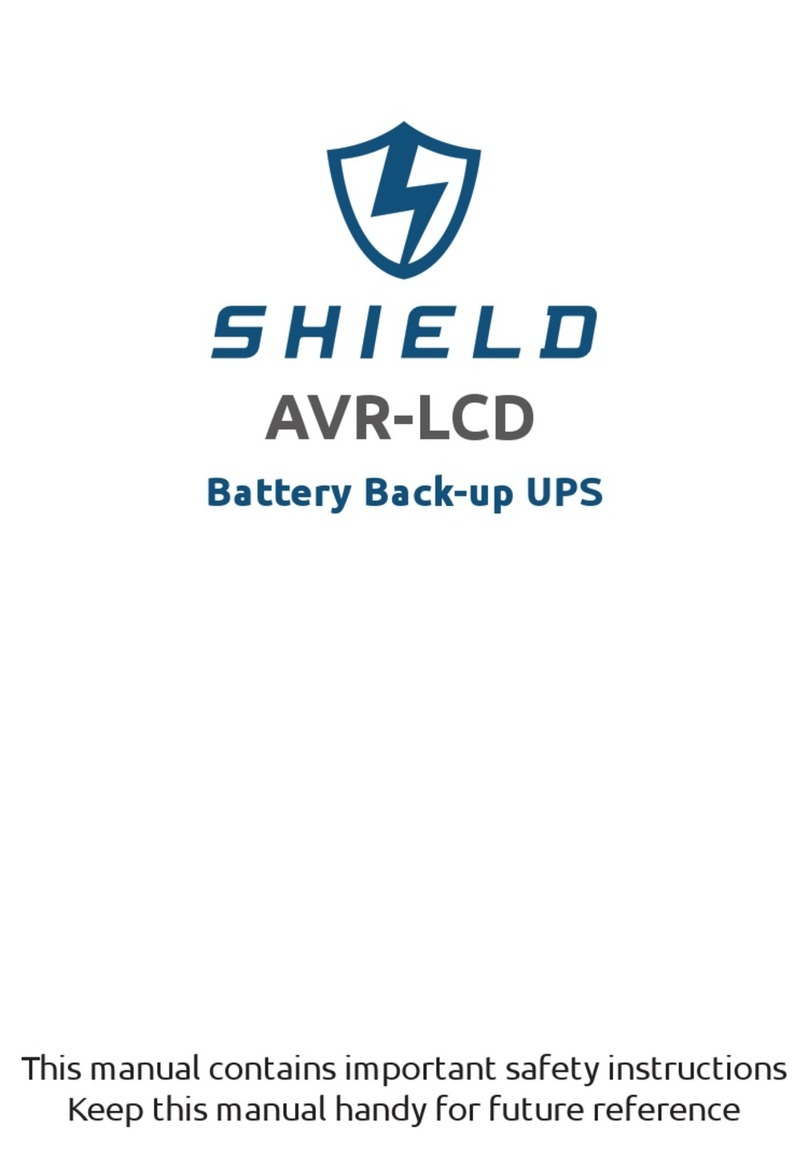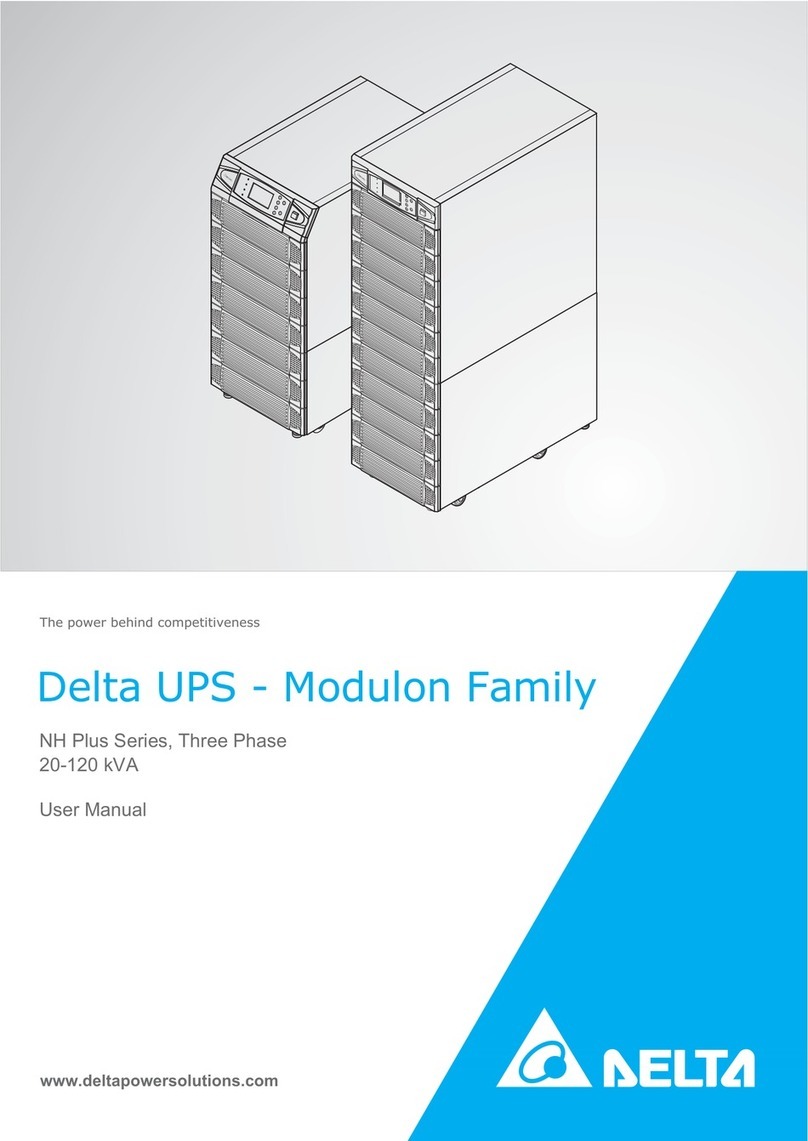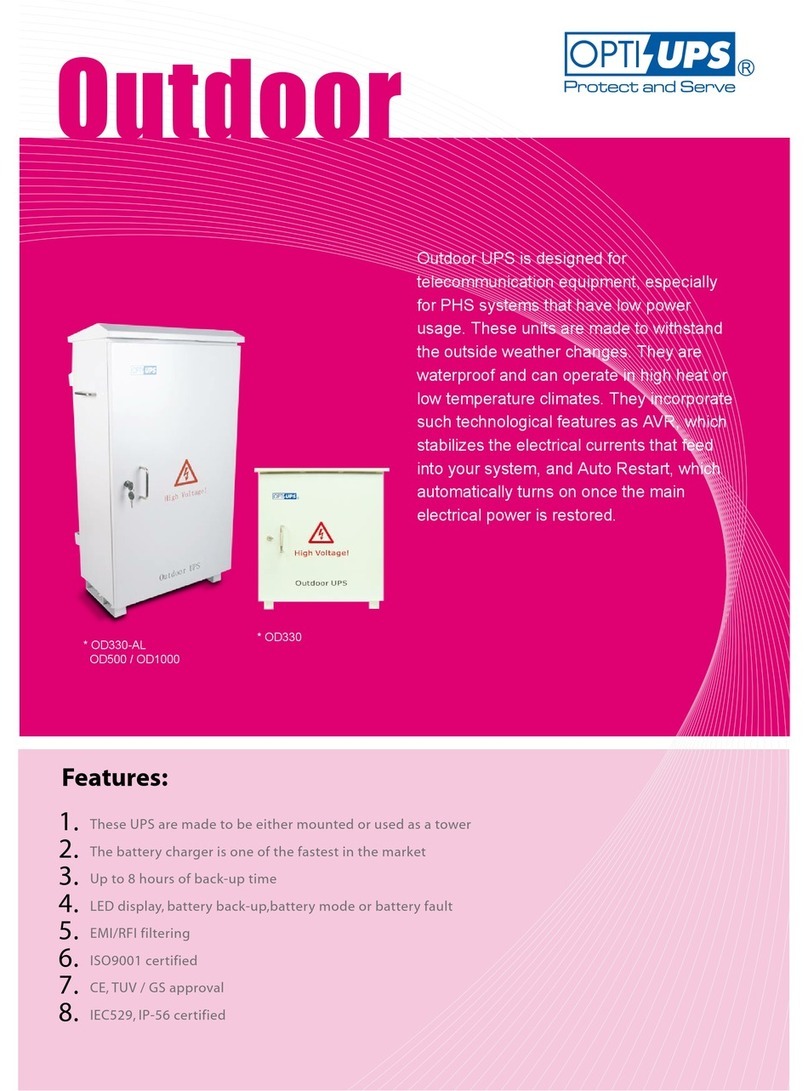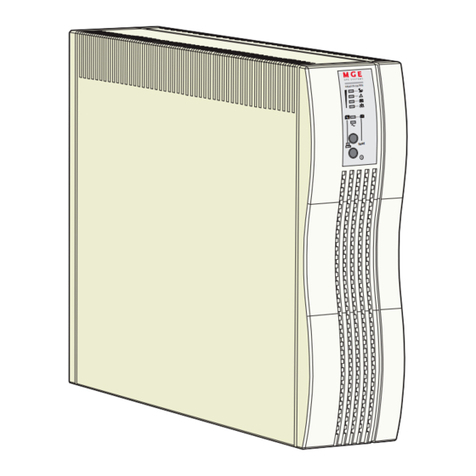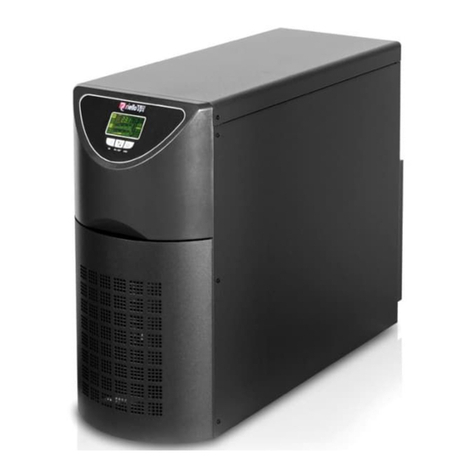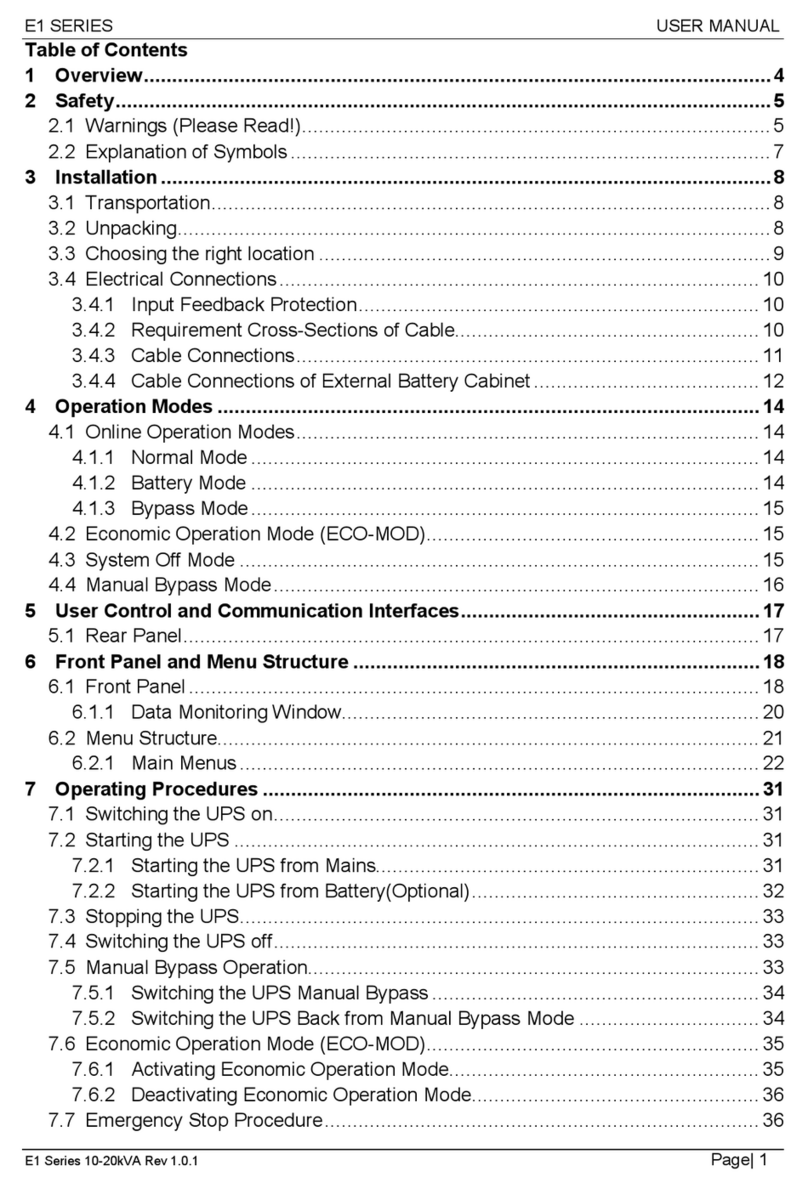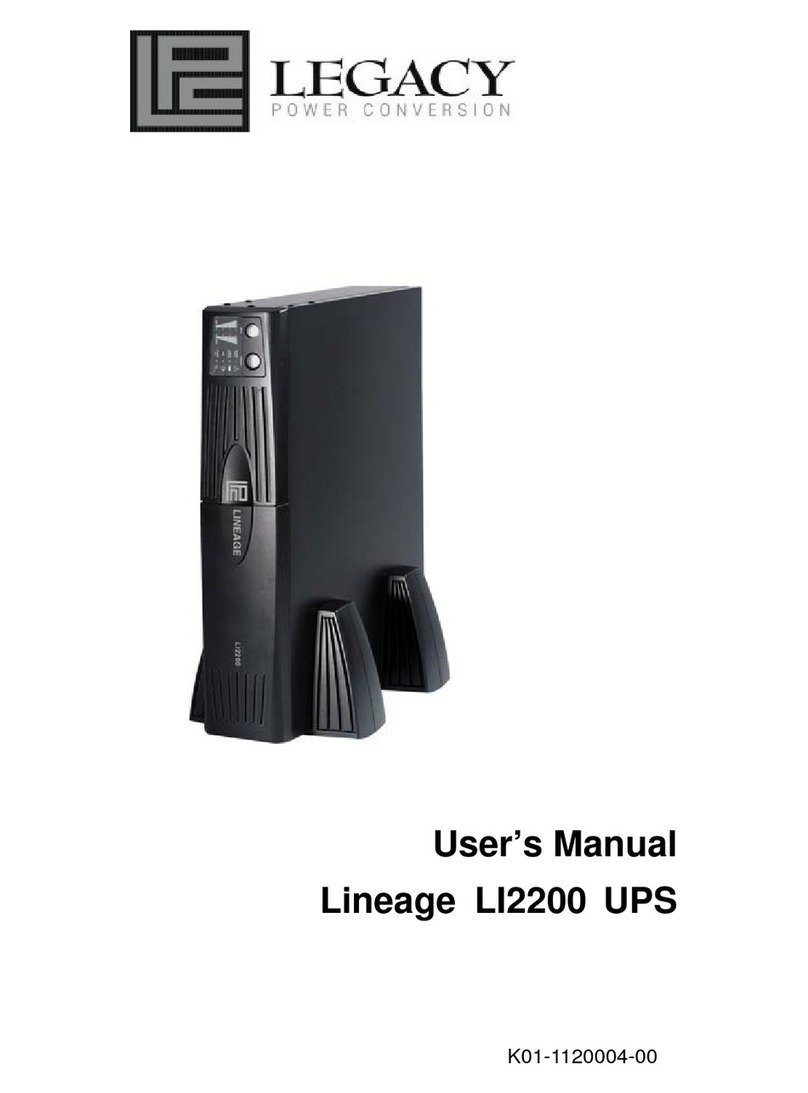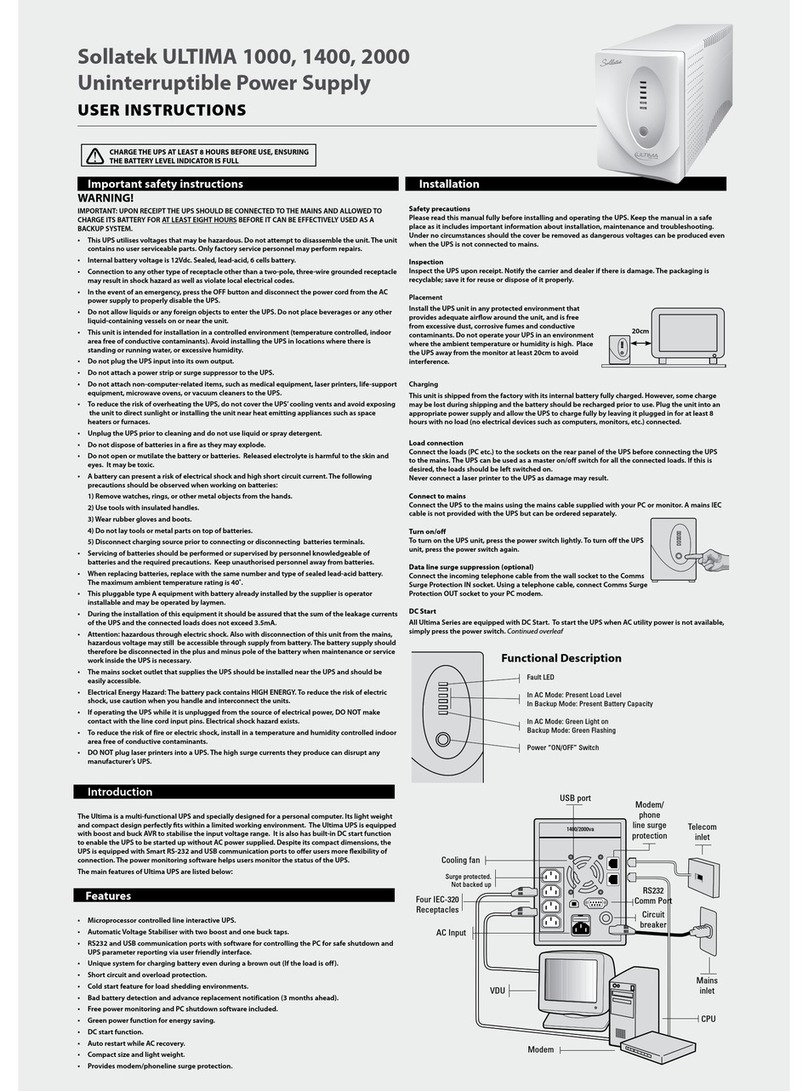Shield M10U User manual


Safety Precautions
Shield M10U user manual I
Safety Precautions
This manual contains information concerning the installation and operation of Modular UPS. Please carefully read this
manual prior to installation.
The Modular UPS cannot be put into operation until it is commissioned by engineers approved by the manufacturer (or
its agent). Not doing so could result in personnel safety risk, equipment malfunction and invalidation of warranty.
The UPS has been designed for commercial or industrial use only, and is not intended for use in any life support
application. This is a CLASS C Uninterruptible Power Supply (UPS) product. In a domestic environment, this product may
cause radio interference, in which case, the user may be required to take additional measures.
Conformity and standards
This product complies with CE73/23 & 93/68 (low voltage safety) and 89/336 (EMC), and the following UPS product
standards:
*IEC62040-1-1-General and safety requirements for use in operator access area
*IEC/EN62040-2 EMC requirements CLASS C
*IEC62040-3 Performance requirements and test methods
For more details, refer to Chapter 9 . Continued compliance requires installation in accordance with these
instructions and the use of manufacturer approved accessories only.
WARNING: high earth leakage current
Earth connection is critical before connecting the input supply (include both utility supply and battery).
"Earth leakage current introduced by the UPS, in any configuration from 10kW to 150kW, exceeds 3.5 mA and is less
than 1000 mA and complies with the requirements of IEC/EN 62040-1 / IEC/EN 60950-1" Transient and steady-state
earth leakage currents, which may occur when starting the equipment, should be taken into account when selecting
instantaneous RCCB or RCD devices.
Residual Current Circuit Breakers ( RCCBs) must be selected sensitive to DC unidirectional pulses (class A) and
insensitive to transient current pulses.
Note also that the earth leakage currents of the load will be carried by this RCCB or RCD.
This equipment must be earthed in accordance with local electrical authority codes of practice.
WARNING: backfeeding protection
This system has a control signal available for use with an automatic device, externally located, to protect against
backfeeding voltage through the mains Static Bypass circuit. If this protection is not used with the switchgear that
is used to isolate the bypass circuit, a label must be added to the switchgear to advise service personnel that the
circuit is connected to a UPS system.
The text has the following meaning or is equivalent to: Isolate the UPS before working on the circuit of this UPS.
Components that can be maintained by user
All the equipment maintenance and servicing procedures involving internal access need special tools and should be
carried out only by trained personnel. The components that can only be accessed by opening the protective cover
with tools cannot be maintained by user.
This UPS full complies with “IEC62040-1-1-General and safety requirements for use in operator access area UPS”.
Dangerous voltages are present within the battery box. However, the risk of contactor with these high voltages is
minimized for non-service personnel. Since the component with dangerous voltage can only be touched by opening
the protective cover with a tool, the possibility of touching high voltage component is minimized. No risk exists to
any personnel when operating the equipment in the normal manner, following the recommended operating
procedures in this manual.
警告
危险
警告
危险
警告
危险
警告
危险

Safety Precautions
II Rack Modular UPS System 10-90kVA User Manual
Battery voltage higher than 400Vdc
All the battery maintenance and servicing procedures involving internal access need special tools or keys and should
be carried out only by trained personnel.
SPECIAL CARE SHOULD BE TAKEN WHEN WORKING WITH THE BATTERIES ASSOCIATED WITH THIS EQUIPMENT.
WHEN CONNECTED TOGETHER, THE BATTERY TERMINAL VOLTAGE WILL EXCEED 400Vdc AND IS POTENTIALLY
LEATHAL.
Battery manufacturers supply details of the necessary precautions to be observed when working on, or in the vicinity
of, a large bank of battery cells. These precautions should be followed implicitly at all times. Particular attention
should be paid to the recommendations concerning local environmental conditions and the provision of protective
clothing, first aid and fire-fighting facilities.
警告
危险

Contents
Shield M10U user manual III
Contents
Safety Precautions.................................................................................................................................
Chapter 1 Installation..........................................................................................................................1
1.1 Introduction............................................................................................................................1
1.2 Initial Checking.......................................................................................................................1
1.3 Location...................................................................................................................................1
1.3.1 UPS Location ...............................................................................................................1
1.3.2 External Battery Room..............................................................................................2
1.3.3 Storing..........................................................................................................................2
1.4 Positioning..............................................................................................................................2
1.4.1 System Cabinet...........................................................................................................2
1.4.2 Moving the Cabinets..................................................................................................3
1.4.3 Clearances Required for Operating ........................................................................3
1.4.4 Front Access ................................................................................................................3
1.4.5 Final Positioning .........................................................................................................3
1.4.6 Installation of Adjustable Feet.................................................................................3
1.4.7 UPS Composition........................................................................................................3
1.4.8 Installing Power Modules .........................................................................................5
1.4.9 Cable Entry ..................................................................................................................7
1.5 External Protective Devices.................................................................................................8
1.5.1 Rectifier and Bypass Input Supply of the UPS.......................................................8
1.5.2 External Battery .........................................................................................................9
1.5.3 UPS Output..................................................................................................................9
1.6 Power Cables..........................................................................................................................9
1.6.1 Cable Connections ...................................................................................................10
1.7 Control Cabling and Communication ...............................................................................11
1.7.1 UPS Dry Contactor and Monitoring Board Features ..........................................11
1.7.2 Dry Contactor Interface of Battery and Environmental Temperature Detection
...............................................................................................................................................12
1.7.3 Remote EPO Input Port...........................................................................................12
1.7.4 Generator Input Dry Contactor..............................................................................13
1.7.5 BCB Input Port..........................................................................................................14
1.7.6 Battery Warning Output Dry Contactor Interface..............................................14
1.7.7 Integrated Warning Output Dry Contactor Interface........................................15
1.7.8 Mains Failure Warning Output Dry Contactor Interface....................................15
Chapter 2 Battery Installation and Maintenance .........................................................................17
2.1 General Recommendations ...............................................................................................17
2.2 Battery Typologies..............................................................................................................18
2.2.1 Traditional Battery Installation..............................................................................18
2.3 Battery Maintenance ..........................................................................................................19
Chapter 3 Installation of UPS Rack System ...................................................................................20
3.1 Overview...............................................................................................................................20
3.2 UPS Rack Modules in Parallel System ..............................................................................21
3.2.1 Installation of Cabinet.............................................................................................21
3.2.2 External Protective Devices ...................................................................................21
3.2.3 Power Cables.............................................................................................................21
3.2.4 Parallel Signal Board................................................................................................21
3.2.5 Control Cables ..........................................................................................................21
Chapter 4 Installation Drawing........................................................................................................23
Chapter 5 Operations........................................................................................................................30
5.1 Introduction..........................................................................................................................30

Contents
IV Rack Modular UPS System 10-90kVA User Manual
5.1.1 Split-Bypass Input.....................................................................................................31
5.1.2 Static Transfer Switch..............................................................................................31
5.2 1+1 Parallel System.............................................................................................................31
5.2.1 Features of Parallel System....................................................................................31
5.2.2 Parallel Requirements of UPS Modules................................................................31
5.3 Operating Mode ..................................................................................................................32
5.3.1 Normal Mode ............................................................................................................32
5.3.2 Battery Mode............................................................................................................32
5.3.3 Auto-Restart Mode ..................................................................................................32
5.3.4 Bypass Mode .............................................................................................................32
5.3.5 Maintenance Mode (Manual Bypass)....................................................................32
5.3.6 Parallel Redundancy Mode (System Expansion) .................................................32
5.3.7 Eco Mode ...................................................................................................................32
5.4 Battery Management—Set During Commissioning ......................................................33
5.4.1 Normal Function.......................................................................................................33
5.4.2 Advanced Functions (Software Settings Performed by the Commissioning
Engineer) .............................................................................................................................33
5.5 Battery Protection (Settings by Commissioning Engineer)..........................................33
Chapter 6 Operating Instructions...................................................................................................34
6.1 Introduction..........................................................................................................................34
6.1.1 Power Switches.........................................................................................................34
6.2 UPS Startup ..........................................................................................................................34
6.2.1 Start-Up Procedure ..................................................................................................34
6.2.2 Procedures for Switching Between Operation Modes ......................................35
6.3 Procedure for Switching the UPS between Maintenance Bypass and Normal Mode
......................................................................................................................................................36
6.3.1 Procedure for Switching from Normal Mode to Maintenance Bypass Mode 36
6.3.2 Procedure for Switching from Maintenance Mode to Normal Mode..............36
6.4 Procedure for Completely Powering Down a UPS.........................................................37
6.5 EPO Procedure.....................................................................................................................37
6.6 Auto Start .............................................................................................................................38
6.7 UPS Reset Procedure..........................................................................................................38
6.8 Operation Instruction for Power Module Maintenance ...............................................38
6.9 Language Selection.............................................................................................................39
6.10 Changing the Current Date and Time ............................................................................39
6.11 Control Password 1...........................................................................................................39
Chapter 7 Operator Control and Display Panel ............................................................................40
7.1 Introduction..........................................................................................................................40
7.1.1 Mimic Current Path ..................................................................................................41
7.1.2 Audible Alarm (buzzer)............................................................................................41
7.1.3 Functional Keys.........................................................................................................41
7.1.4 Battery Pack Indicator.............................................................................................42
7.2 LCD Display Type .................................................................................................................42
7.3 Detailed Description of Menu Items................................................................................43
7.4 UPS Event Log ......................................................................................................................49
Chapter 8 Optional Parts..................................................................................................................55
8.1 Install SNMP card.................................................................................................................55
Chapter 9 Product Specification .....................................................................................................56
9.1 Applicable Standards..........................................................................................................56
9.2 Environmental Characteristics ..........................................................................................56
9.3 Mechanical Characteristics ................................................................................................56
9.4 Electrical Characteristics (Input Rectifier).......................................................................57
9.5 Electrical Characteristics (Intermediate DC Link) ..........................................................57

Contents
Shield M10U user manual V
9.6 Electrical Characteristics (Inverter Output)....................................................................57
9.7 Electrical Characteristics (Bypass Input) .........................................................................58
9.8 Efficiency...............................................................................................................................59
Appendix A. Power Connection of Modular System....................................................................60

Table of Figures
VI Rack Modular UPS System 10-90kVA User Manual
Table of Figures
Fig.1- 1: UPS Structure ................................................................................................................5
Fig.1- 2: Power Module Installation ..........................................................................................6
Fig.1- 3: rack mounted installation............................................................................................7
Fig.1- 4: cable entry .....................................................................................................................8
Fig.1- 5: The Symbols of RCCB ...................................................................................................9
Fig.1- 6: Bypass Module (include bypass and monitoring) ..................................................12
Fig.1- 7: Diagram of J2 and J3 Dry Contactor of Temperature Detection .......................12
Fig.1- 8: Diagram of Input Dry Contactor for Remote EPO.................................................13
Fig.1- 9: Connection of Generator...........................................................................................13
Fig.1- 10: BCB Interface ............................................................................................................14
Fig.1- 11: Battery Low Warning Dry Contactor .....................................................................14
Fig.1- 12: Integrated warning dry contactor..........................................................................15
Fig.1- 13: Utility Failure Warning Dry Contactor ...................................................................15
Fig.2- 1: Diagram of Batteries Connection ............................................................................18
No table of figures entries found.
Fig.3- 1: Circuit diagram of EPO...............................................................................................20
Fig.3- 2: Parallel Board ..............................................................................................................21
Fig.3- 3: Connection of Parallel Cables of "1+N" System ....................................................22
Fig.4- 1: Wiring Diagram............................................................................................................23
Fig.4- 2: External Battery Connection ....................................................................................23
Fig.4- 3: 90kVA UPS module System, Front View and Rear View without Door..............24
Fig.4- 4: 40KVA UPS Module System, Front View and Rear View without Door .............24
Fig.4- 5: 20KVA UPS Module System, Front View and Rear View without Door .............24
Fig.4- 6: 90KVA UPS External Dimensions .............................................................................25
Fig.4- 7: 40KVA UPS External Dimensions .............................................................................25
Fig.4- 8: 20KVA UPS External Dimensions .............................................................................26
Fig.4- 9: Power Connection of Module System UPS.............................................................27
Fig.4- 10: Power Module ...........................................................................................................27
Fig.4- 11: Monitoring and Bypass Module .............................................................................28
Fig.4- 12: cables routing (dry contactoror, RS485, SNMP) ..................................................29
Fig.5- 1: Single Unit Block Diagram.........................................................................................30
Fig.6- 1: External Maintenance Bypass...................................................................................36
Fig.7- 1: UPS operator control and display panel .................................................................40
Fig.7- 2: Main LCD Display.........................................................................................................42
Fig.7- 3: Menu Structure ...........................................................................................................43
Fig.7- 4: cabinet menu...............................................................................................................44
Fig.7- 5: main input and output information.........................................................................44
Fig.7- 6: load and battery information ...................................................................................45
Fig.7- 7: power module information .......................................................................................45
Fig.7- 8: module output and load information......................................................................46
Fig.7- 9: module information and S-code...............................................................................46
Fig.7- 10: Setting Menu .............................................................................................................46
Fig.7- 11: System Operate ........................................................................................................48
Fig.7- 12: output and bypass waveform .................................................................................49
Fig.8- 1: SNMP card....................................................................................................................55
Fig.B- 1: Power Connection of 2 slots and 4 slots ................................................................60
Fig.B- 2: Power Cables Connection of 6 slots cabinet..........................................................60

Table of Tables
Shield M10U user manual VII
Table of Tables
Table.1- 1: UPS Configuration List.............................................................................................5
Table.1- 2: Maximum Steady State AC and DC Current .........................................................9
Table.1- 3: Description of Input Dry Contactor.....................................................................12
Table.1- 4: Description of Input Dry Contactor for Remote EPO.......................................13
Table.1- 5: Description of Status Interface and Connection of Generator.......................13
Table.1- 6: Description of BCB Interface................................................................................14
Table.1- 7: Battery warning dry contactor interface description ......................................14
Table.1- 8: Integrated warning dry contactor interface description.................................15
Table.1- 9: Description of Mains failure warning dry contactor.........................................15
Table.7- 1: Description of UPS Operator Control and Display Panel.................................40
Table.7- 2: Status Description of Indicator ............................................................................41
Table.7- 3: Description of Audible Alarm ...............................................................................41
Table.7- 4: Functions of Functional Keys................................................................................41
Table.7- 5: Description of LCD Icons .......................................................................................42
Table.7- 6: Description of Items in UPS System Information Window ..............................43
Table.7- 7: description of details of submenu in setting.....................................................46
Table.7- 8: UPS Event List .........................................................................................................49
Table.9- 1: Compliance with European and International Standards ................................56
Table.9- 2: Environmental Properties.....................................................................................56
Table.9- 3: Mechanical Properties ...........................................................................................56
Table.9- 4: Rectifier AC Input (mains) .....................................................................................57
Table.9- 5: Battery Information ...............................................................................................57
Table.9- 6: Inverter Output (to Critical Load) ........................................................................57
Table.9- 7: Bypass Input ............................................................................................................58
Table.9- 8: Efficiency, Air Exchange ........................................................................................59


Chapter 1 Installation
Shield M10U user manual 1
Chapter 1 Installation
1.1 Introduction
This chapter introduces the relevant requirements for positioning and cabling of the Modular UPS and related equipment.
Because each site has its requirements, it is not the aim of this chapter to provide step-by-step installation instructions,
but to act as a guide for the general procedures and practices that should be observed by the installing engineer.
Warning: installation can only be done by authorized engineers
Do not apply electrical power to the UPS equipment before the commissioning engineer arrives at installation site.
The UPS should be installed by a qualified engineer in accordance with the information contained in this chapter. All
the equipment not referred to in this manual is shipped with details of its own mechanical and electrical installation
information.
Note: 3-Phase 4-Wire Input Power is required
The standard UPS system can be connected to TN, TT AC distribution system (IEC60364-3) of 3-phase 4-wire, and a 3-
wire to 4-wire conversion transformer is provided as an optional part. 1-phase 3-wires is also provided as an optional
part.
WARNING: battery hazards
SPECIAL CARE SHOULD BE TAKEN WHEN WORKING WITH THE BATTERIES ASSOCIATED WITH THIS EQUIPMENT.
When connecting the battery, the battery terminal voltage will exceed 400Vdc and is potentially lethal.
Eye protection should be worn to prevent injury from accidental electrical arcs.
Remove rings, watches and all metal objects.
Only use tools with insulated handles.
Wear rubber gloves.
If a battery leaks electrolyte, or is otherwise physically damaged, it must be replaced, stored in a container
resistant to sulfuric acid and disposed of in accordance with local regulations.
If electrolyte comes into contactor with the skin, the affected area should be washed immediately with water.
1.2 Initial Checking
Perform the following checking operations prior to the UPS installation.
1. Visually examine if there is any damage inside and outside the UPS rack and battery equipment due to the
transportation. Report any such damage to the shipper immediately.
2. Verify the product label and confirm the correctness of the equipment. The equipment label is attached on the back
of front door. The UPS model, capacity and main parameters are marked on the label.
1.3 Location
1.3.1 UPS Location
The UPS is intended for indoor installation and should be located in a cool, dry and clean environment with adequate
ventilation to keep the environmental parameters within the specified operating range (see Table.9-2).The Modular series
UPS uses forced convection cooling by internal fans. Cooling air enters the module through ventilation grills located at
the front part of the cabinet and exhausted through grills located in the rear part of the cabinet. Please do not block the
ventilation holes.
警告
危险
警告
危险
警告
危险

Chapter 1 Installation
2 Shield M10U user manual
If necessary, a system of extractor fans should be installed to aid cooling-air flow. An air filter should be used when the
UPS is to operate in a dirty environment and should be regularly cleaned to maintain airflow. The cooling capacity of air
conditioner should be selected according to the power loss data of UPS specified in Table.9-8: Normal mode (VFI SS 111
double-conversion UPS)
Note: The UPS should be installed on a cement surface or other surface that is not combustible.
1.3.2 External Battery Room
The battery will generate some amount of hydrogen and oxygen at the end of charging, so the fresh air volume of the
battery installation environment must meet EN50272-2001 requirements.
The ambient temperature of the battery must be stable. Ambient temperature is a major factor in determining the
battery capacity and life. The nominal operating temperature of battery is 20°C. Operating above this temperature will
reduce the battery life, and operation below this temperature will reduce the battery capacity. If the average operating
temperature of battery is increased from 20ºC to 30ºC, then the service life of the battery will be reduced by 50%. If the
operating temperature of the battery is above 40ºC, then the battery service life will be decreased in exponent rate. In
a normal installation, the battery temperature is maintained between 15°C and 25°C. Keep batteries away from heat
sources or air outlets.
If external batteries are to be used, the battery circuit breakers (or fuses) must be mounted as close as possible to the
batteries, and the connecting cables should be as short as possible.
1.3.3 Storing
Should the equipment not be installed immediately, it must be stored in a room so as to protect it against excessive
humidity and heat sources (see Table.9-2).The battery needs to be stored in dry and cool place with good ventilation. The
most suitable storage temperature is 20 ºC to 25ºC.
Preventing battery deep discharge
Should the UPS remains unpowered for a prolonged period of time while the battery are connected, the batteries
may deeply discharge and being so permanently damaged .In such cases it is therefore recommended to leave the
battery circuit breaker(s) open. During storage in any case, periodically charge the battery according to the battery
user manuals.
1.4 Positioning
When the equipment has been finally positioned, ensure the UPS will remain stationary and stable. To prolong the service
life, the place chosen must guarantee:
Space for easy operation on the UPS
Air sufficient enough to dispel heat produced by UPS
Against atmospheric agents
Against excessive humidity and heat sources
Against dust
With the current fire prevention requirements
The operating environment temperature is within +20°C to +25°C. The batteries are at maximum efficiency in this
temperature range (for information about the battery storage and transportation as well as the environment, refer
to Table.9-2 )
This equipment is of steel frame structure wrapped by removable panels. The top and side panels are fixed by
screws.
After opening the UPS rack door, the auxiliary connections for external low voltage interface and the maintenance
bypass can be accessed. The UPS rack has an operator and control panel located on its front door, which provides
the basic operating status and alarm information. Batteries are external. The UPS provides air inlet port in the front
and the air exhaust port in the rear part.
1.4.1 System Cabinet
A UPS system can comprise an UPS rack system, external battery cabinet, depending on the specific system requirement.
All the UPS system cabinets used in the same installation site are of the same height and should be positioned side-by-
警告
危险

Chapter 1 Installation
Shield M10U user manual 3
side to achieve an aesthetically appealing effect. Refer to Chapter 7 Installation Drawing for the positioning of UPS
cabinet.
1.4.2 Moving the Cabinets
Warning
Ensure that any lifting equipment used in moving the UPS cabinet has sufficient lifting capacity. The UPS is fitted with
castors – take care to prevent movement when unbolting the equipment from its shipping pallet. Ensure adequate
personnel and lifting aids are available when removing the shipping pallet.
Ensure that the UPS weight is within the weight loading capacity range of any hoisting equipment. See Table.9-3 for UPS
weight.
UPS and optional cabinets can be handled by means of a fork lift or similar equipment. The UPS cabinet can also be moved
by its castors when moving in a short distance.
Note: Care must be taken when handling units fitted with batteries. Keep such moves to a minimum.
1.4.3 Clearances Required for Operating
As rack module UPS has no ventilation grills at either sides, no clearances are required for the sides.
To enable routine tightening of power terminations within the UPS, it is recommended that clearance around the front
of the equipment should be sufficient to enable free passage of personnel with the doors fully opened. It is important
to leave a distance of 500mm in the rear side of the rack to permit adequate circulation of air coming out of the unit.
If the UPS make use of internal modular battery sufficient clearing shall be given at the back site to allow personnel to
operate the battery circuit breakers
1.4.4 Front Access
The component layout of the UPS rack system supports front access and repairing the UPS, thus reducing the space
requirement for side access.
1.4.5 Final Positioning
When the equipment has been finally positioned, ensure the adjustable feet are set so that the UPS will remain stationary
and stable.
1.4.6 Installation of Adjustable Feet
Installation diagrams in Chapter 4 of this manual identify the location of the holes in the base plate through which the
equipment can be bolted to the floor. If the UPS is to be located on a raised floor, it should be mounted on a pedestal
suitably designed to accept the UPS point loading (more than 150 kg).
1.4.7 UPS Composition
The UPS structure is shown in Fig. 1-1. The UPS configuration is provided in Table. 1-1
警告
危险

Chapter 1 Installation
4 Shield M10U user manual
panel
Power
module
SNMP parallel
Dry
contactor
Manual
breaker
(a) 6 modules cabinet
Bypass
module
Power
module
connector
breakers
Ellipse
cable entry
Round
cable entry
(b) 4 modules cabinet
Bypass module
Power module
Manual bypass
Dry contactor
SNMP RS485
RS232
Parallel
Ellipse cable
entry
(c) 3 modules cabinet

Chapter 1 Installation
Shield M10U user manual 5
Bypass
module
Power
module
breakers
connector
Ellipse
cable
entry
Round
cable
entry
(d) 2 modules cabinet
Fig.1- 1: UPS Structure
Table.1- 1: UPS Configuration List
Item
Component
Quantity
Remarks
1
System Display
1
Requisite, factory installed
2
Bypass module
1
Requisite, factory installed
3
Bypass/maintenance
bypass breakers
1
Requisite, factory installed
4
Power module
1 ≤n ≤6
Requisite
5
Decorative metal strip
2
Factory installed
1.4.8 Installing Power Modules
The number and possible installation positions of the Power Modules may vary according to the chosen factory
configuration. Please install the power modules from bottom to top, so as to avoid cabinet toppling due to high gravity
center.
Installation procedures of power modules
When installing power modules always work from the lower available space upwards to prevent from raising the center
of gravity. The default setting from the bottom space upwards is NO.1 to NO.2 (2 modules cabinet), NO.1 to NO.3 (3
modules cabinet), NO.1 to NO.4 (4 modules cabinet), NO.1 to NO.6 (6 modules cabinet).
Notes
If installed as standalone unit, it’s recommended that install power modules from upper available space downwards
to prevent from corrosion of the bottom module.
Recover decorative metal strips on the two side of front panel. Loose screws through holes on metal strips, pull
metal strips upwards then take away the strips as Fig.1-2(a).
Insert the module in the installation position, and push it into the cabinet.
Secure the module to the cabinet through the fixing holes on both sides of the front panel of the module.
Loose the upper and bottom 4 screws and fix two side decorative metal strips (as Fig.1-2) to cover the screws on
front side following Fig.1-2(c)(d).
警告
危险

Chapter 1 Installation
6 Shield M10U user manual
(a) Remove side decorative metal strips (b) insert power module
Screws*4
(c) recover the decorative metal strips (d) fasten the strips
Fig.1- 2: Power Module Installation
When using the UPS in a rack-mount configuration, the UPS must be supported by a slide kit, fixed rails or a shelf. Fasten
slide kit into the rack enclosure. Remove side panels and holders of UPS as Fig.1-3. Lay the UPS in rack-mounting position.
Fasten the UPS into the rack enclosure with (20)M6 screws
(a) Remove side panels and holders

Chapter 1 Installation
Shield M10U user manual 7
b. fasten cabinet into rack enclosure
Fig.1- 3: rack mounted installation
Warning
Servicer rack enclosure within side doors should be chosen to cover side panel of UPS cabinet, otherwise the
connector for power modules might be touched with tools like screwdriver.
1.4.9 Cable Entry
Cables can enter the module UPS rack system both from bottom and back. The recommended installation practice is to
connect cables through ellipse hole to prevent foreign material or vermin entering the cabinet. Use circular entry
protector if ellipse hole is not big enough. If connect cables through bottom entry, remove the cover and install a rubber
cable protector in the bottom entry hole firstly.
Cable entry is followed as fig.1-4.
(a) 2-module or 4-module cabinet cables entry
警告
危险

Chapter 1 Installation
8 Shield M10U user manual
Reserved
entry hole
(b) 6-module cabinet cables entry
Fig.1- 4: cable entry
Notes
Cables connection should be followed as diagram on rear panel or appendix B (2-module and 4-module cabinet)
Fix cables in 6-module cabinet as Fig.1-4(b) to make sure best ventilation.
Enter through reserved entry cover if ellipse holes are not big enough, and block the remained space to protect UPS
from rats.
1.5 External Protective Devices
For safety concerns, it is necessary to install external circuit breakers or other protective devices for the input AC supply
of the UPS system. This section provides generic practical information for qualified installation engineers. The
installation engineers should have the knowledge of the regulatory wiring standards, and of the equipment to be
installed.
1.5.1 Rectifier and Bypass Input Supply of the UPS
Over currents
Install suitable protective devices in the distribution unit of the incoming mains supply, considering the power cable
current-carrying capacity and overload capacity of the system (see Tab. 9-7). Generally, the magnetic circuit breaker with
IEC60947-2 tripping curve C (normal) at the 125% of the current listed in Tab. 9-7 is recommended. Split bypass: In case
a split bypass is used, separate protective devices should be installed for the rectifier input and bypass input in the
incoming mains distribution panel.
Note: The rectifier input and bypass input must use the same neutral line.
Protection against earth faults (RCD devices):
The RCD device installed upstream of the input supply should:
警告
危险

Chapter 1 Installation
Shield M10U user manual 9
Sensitive to DC unidirectional pulses (class A) in the network
Insensitive to transient current pulses
Have an average sensitivity that is adjustable between 0.3A and 1A.
Fig.1- 5: The Symbols of RCCB
When using the RCD in the split bypass system or parallel system, the RCD should be installed in the upstream of the
input distribution to avoid wrong alarm.
The residual current introduced by RFI filter in the UPS is between 3.5mA and 1000mA. It is recommended to confirm the
sensitivity of each RCD of upstream input distribution and downstream distribution (to load).
1.5.2 External Battery
The DC compatible circuit breaker provides over current protection for UPS system and battery, which is provided by the
external battery cabinet.
1.5.3 UPS Output
In the eventuality that an external distribution panel is used for load distribution, the selection of protective devices
must provide discrimination with those that are used at the input to the UPS (see Tab. 9-7).
1.6 Power Cables
Design the cables according to the descriptions in this section and local regulatory wiring standards, and the
environmental conditions (temperature and physical support media) should be taken into consideration. Refer to
IEC60950-1 Table 3B Cabling.
WARNING
FAILURE TO FOLLOW ADEQUATE EARTHING PROCEDURES CAN RESULT IN EMI, ELECTRIC SHOCK HAZARD, OR RISK
OF FIRE, SHOULD AN EARTH FAULT OCCUR.
Table.1- 2: Maximum Steady State AC and DC Current
UPS
power(KVA
)
Rated current (A)
Main input current at full load
battery charging1,2
Output current at full load2
Battery discharging current at
E.O.D=1.67V/cell, no overload
380V
400V
415V
380V
400V
415V
36
Batt./stri
ng
38
Batt./stri
ng
40
Batt./st
ring
60
120
120
120
92
87
83
175
166
157
40
80
80
80
61
58
56
117
111
105
30
60
60
60
46
44
42
88
83
79
20
40
40
40
31
29
28
59
56
53
Note:
1. Input current of common input configurations of rectifier and bypass
2. Take special care when determining the size of the output and bypass neutral cable, as the current circulating on the neutral
cable may be greater than nominal current in the case of non-linear loads, which is usually 1.732 times of rated currents.
3. The earth cable connecting the UPS to the main ground system must follow the most direct route possible. The earth
conductor should be sized according to the fault rating, cable lengths, type of protection, etc.
According to AS/IEC60950-1, the cross section area of the conductor is 16mm2/10mm2 (40 input/output), the cross section
area of the conductor is 10mm2/6mm2 (10/20KVA input/output), the cross section area of the conductor is 35mm2/25mm2
(60kVA input/output).
4. When sizing battery cables, a maximum volt drop of 4Vdc. is permissible at the current ratings given in Table.1-2. The load
警告
危险

Chapter 1 Installation
10 Shield M10U user manual
equipment is connected to a distribution network of individually protected busbars fed by the UPS output rather than
connected directly to the UPS. In parallel multi-module systems, the output cable of each ups rack unit should be kept at equal
length between the output of the ups rack output terminals and the parallel distribution busbars to avoid affecting the shared
current. When laying the power cables, do not form coils, so as to avoid the formation of electromagnetic interference.
5. See Chapter 4 Installation Drawing for the positions of wiring terminals.
WARNING
FAILURE TO FOLLOW ADEQUATE EARTHING PROCEDURES CAN RESULT IN EMI, ELECTRIC SHOCK HAZARD OR RISK
OF FIRE, SHOULD AN EARTH FAULT OCCUR.
1.6.1 Cable Connections
Note
The operations described in this section must be performed by authorized electricians or qualified technical
personnel. If you have any difficulties, do not hesitate to contactor our Customer Service & Support department.
After the equipment has been finally positioned and secured, refer to Chapter 4 Installation Drawing to connect the
power cables as described in the following procedures:
1. Verify that all the external input distribution switches of the UPS are completely opened and the UPS internal
maintenance bypass switch is opened. Attach necessary warning signs to these switches to prevent unauthorized
operation.
2. Open rear panel of the UPS, and then the power connection terminals are visible.
3. Connect the protective earth and any necessary grounding cables to the PE terminal. The cabinet for the UPS must be
connected to the user’s ground connection.
Note: The grounding cable and neutral cable must be connected in accordance with local and national codes practice.
Identify and make power connections for incoming cables according to one of the two procedures below, depending on the
type of installation:
Common Input Connections
4. For common bypass and rectifier inputs, connect the AC input supply cables to the UPS input terminals (input A-B-C-N)
Refer to Fig. 4-11 and tighten the connections to 5 Nm (M6 Bolt), 13Nm(M8 Bolt) or 25Nm (M10 Bolt). ENSURE CORRECT
PHASE ROTATION.
Split Bypass Connections(option)
5. If a 'split-bypass' configuration is used, connect the AC input supply cables to the rectifier input terminals (input A-B-
C-N) Refer to Fig.4-11 and the AC bypass supply cables to the bypass input terminals (bypass A-B-C-N) and tighten the
connections to 5 Nm (M6 Bolt) or 13Nm (M8 Bolt) or 25Nm (M10 Bolt). ENSURE CORRECT PHASE ROTATION.
Note: For split Bypass operation ensure that the busbars between Bypass and Rectifier inputs are removed. The neutral
line of bypass input must be connected to that of the rectifier input.
Frequency Converter Mode
If the frequency converter configuration is used, connect the AC input cables to the rectifier input terminals (input A-B-
C-N) Refer to Fig.4-11 and tighten the connections to 5Nm (M6 bolt), or to 13Nm (M8 bolt), or to 25Nm (M10 bolt).
ENSURE CORRECT PHASE ROTATION AND TIGHTEN CONNECTION TERMINALS. No need to connect the bypass input
cables to bypass input terminals (bA-bB-bC-bN).
Note: For the frequency converter operation mode, ensure that the busbars between Bypass and Rectifier inputs are
removed.
Output System Connections
6. Connect the system output cables between the UPS output busbars (output A-B-C-N) Refer to Fig.4-11 and the critical
load and tighten the connections to 5Nm (M6 Bolt) or to 13Nm (M8 Bolt) or to 25Nm(M10 Bolt). ENSURE CORRECT PHASE
ROTATION.
WARNING
If the load equipment will not be ready to accept power on the arrival of the commissioning engineer, then ensure
that the system output cables are safely isolated at their ends.
7. Re-install all the protective covers.
警告
危险
警告
危险
警告
危险

Chapter 1 Installation
Shield M10U user manual 11
1.7 Control Cabling and Communication
1.7.1 UPS Dry Contactor and Monitoring Board Features
According to the specific needs of the field, the UPS may need auxiliary connection to realize the management of the
battery system (including external battery switch and battery temperature sensor), communicate with PC, provide alarm
signal to external device, or realize remote EPO. These functions are realized through the UPS dry contactor board (GJ)
and monitoring board (JK) at the front of bypass module. The boards provide the following interfaces:
EPO
Environment and battery temperature input interface
Generator input dry contactor interface
Battery warning output dry contactor interface
Battery circuit breaker interface
Mains failure warning output dry contactor interface
Intellislots (TM) intelligent card interface
User communication interface
The UPS dry contactor board provides input dry contactors and output dry contactors.
LCD Indicator LED Dry
contactor
EPO RS232 RS485 SNMP
(a) 20kVA/40kVA bypass module
Functional button
LCD LED indicator EPO
(b) 30kVA/45kVA bypass module
Table of contents
Other Shield UPS manuals
Popular UPS manuals by other brands

CyberPower
CyberPower CyberShield CSN27U12V-NA3-G user manual
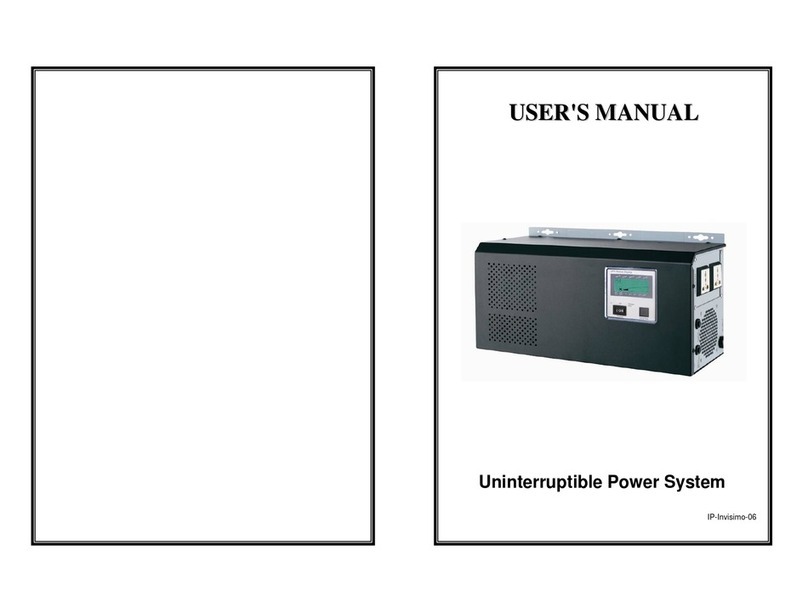
Power-all
Power-all Uninterruptible Power System user manual
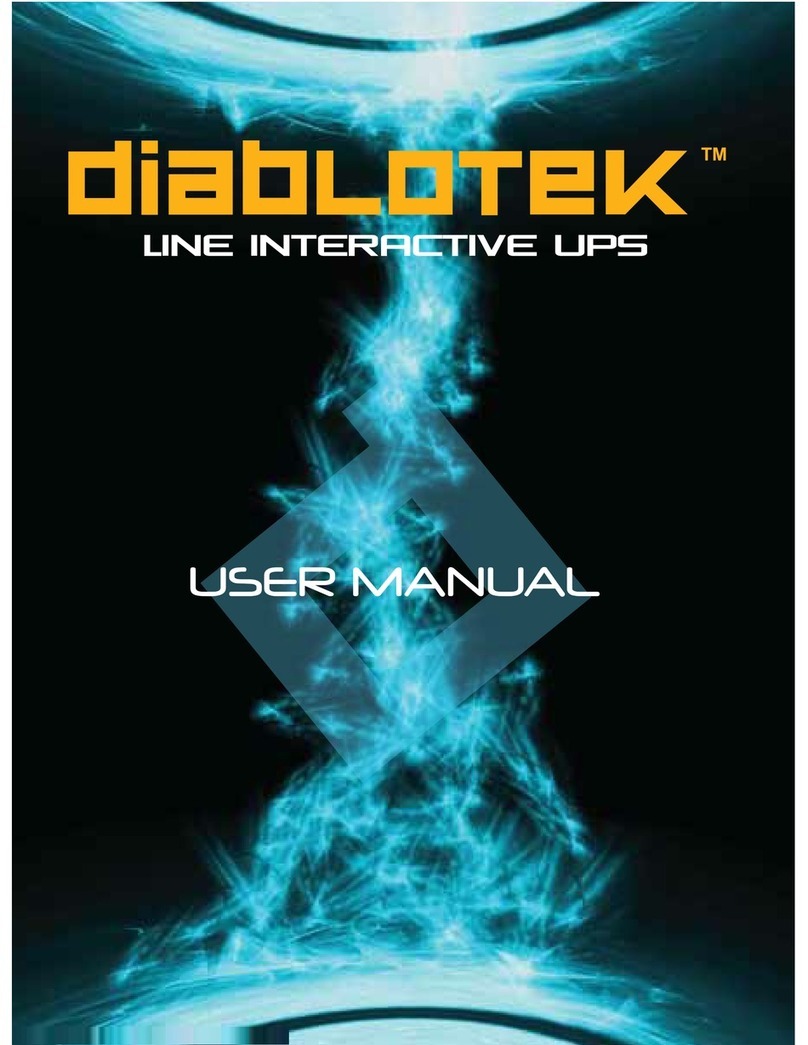
Diablotek
Diablotek UDP-600 user manual
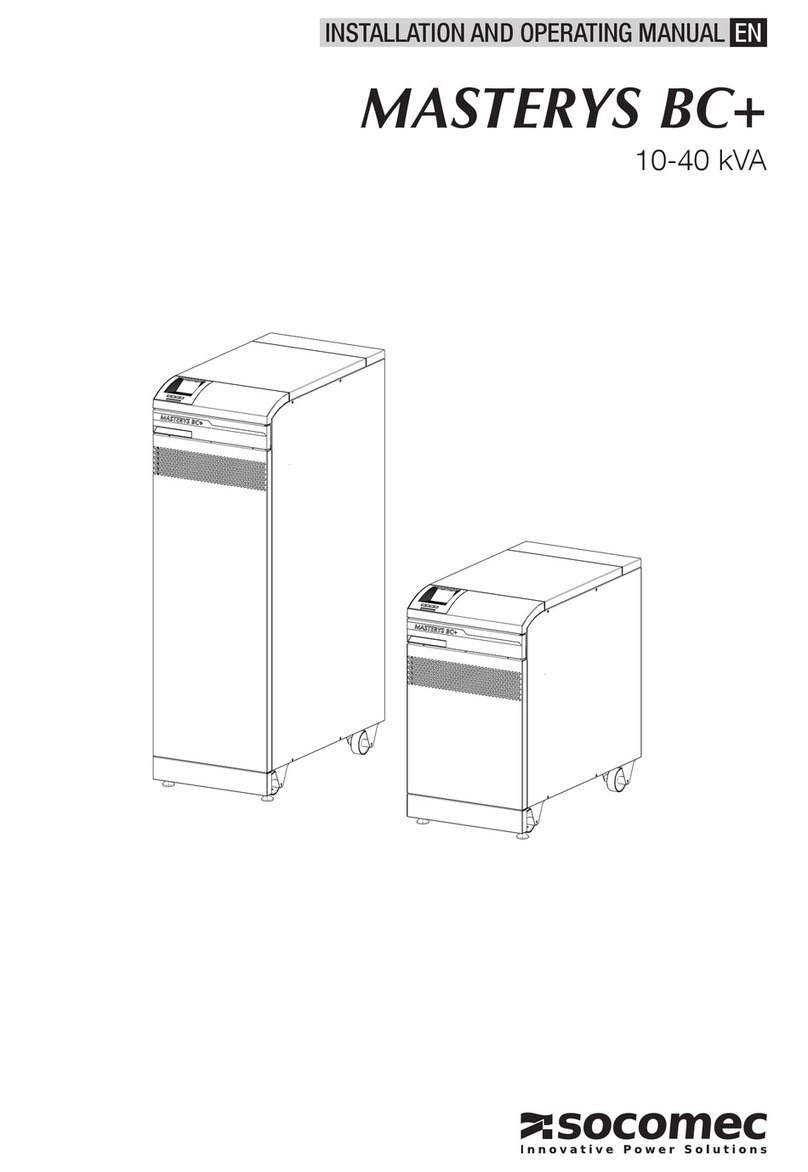
socomec
socomec MASTERYS BC+ 10 kVA Installation and operating manual
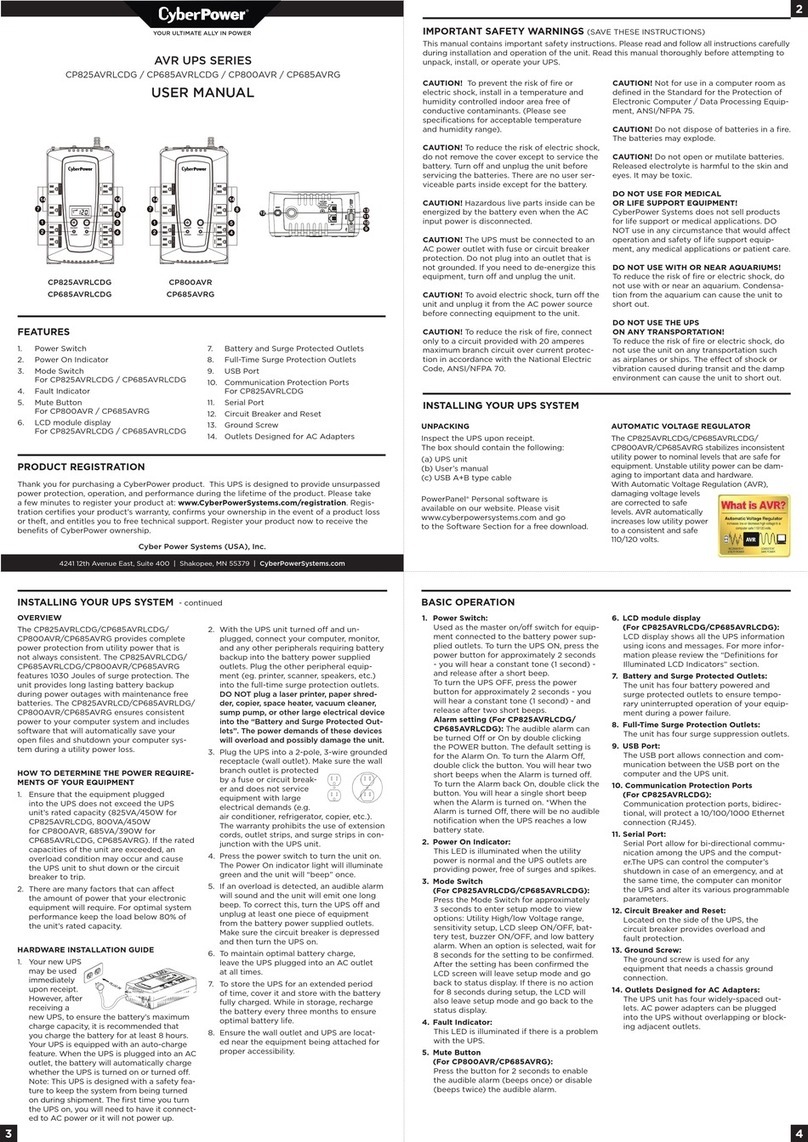
CyberPower
CyberPower AVR Series user manual
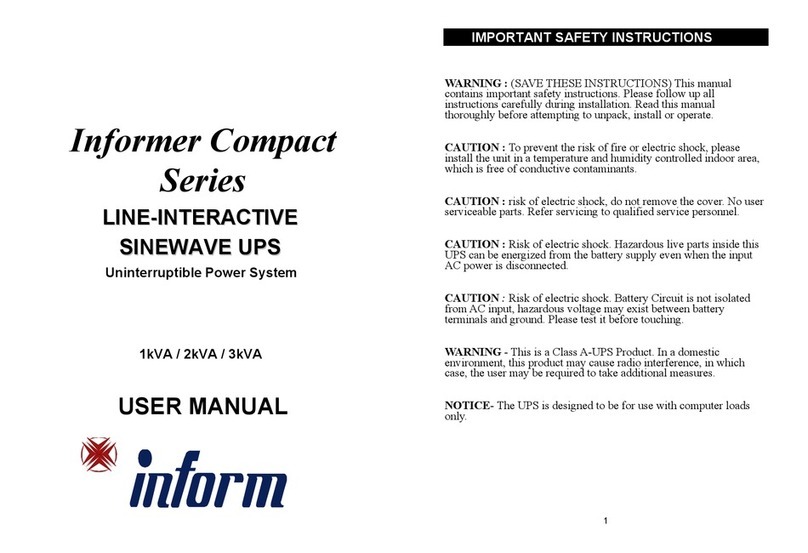
inform
inform Informer Compact Series user manual
